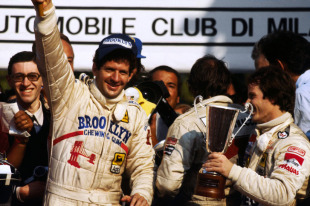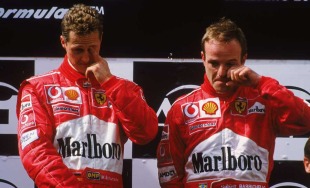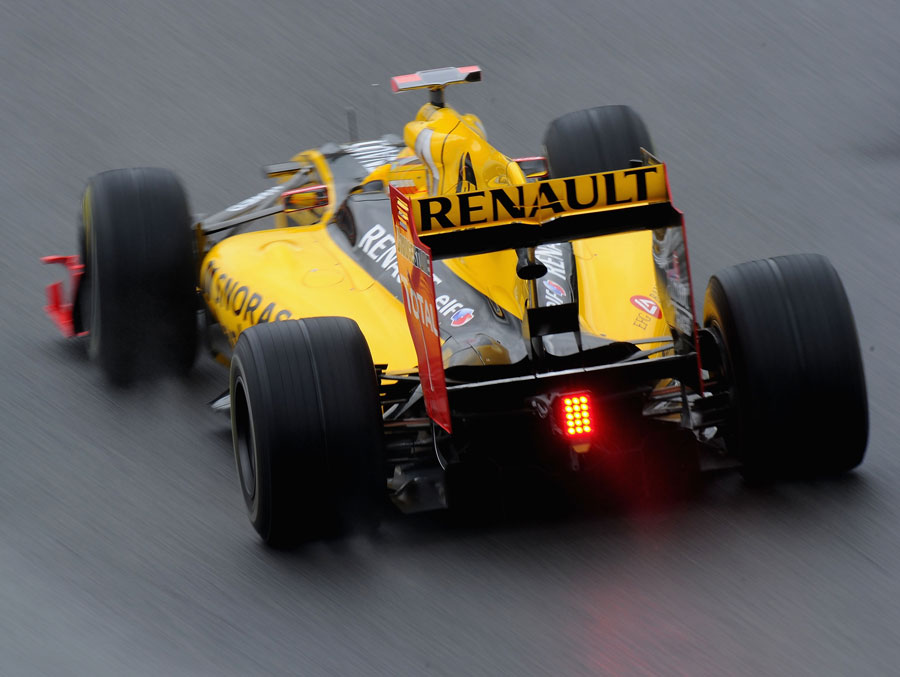With Mark Webber committing his future to Red Bull for 2013 it extends his partnership alongside Sebastian Vettel in to a fifth season. ESPNF1 looks at ten other successful driver pairings in terms of results

- Drivers:
- Rubens Barrichello
- |
- Jack Brabham
- |
- François Cevert
- |
- Peter Collins
- |
- David Coulthard
- |
- Juan Manuel Fangio
- |
- Mika Häkkinen
- |
- Mike Hawthorn
- |
- Denny Hulme
- |
- Niki Lauda
- |
- Nigel Mansell
- |
- Stirling Moss
- |
- Riccardo Patrese
- |
- Alain Prost
- |
- Clay Regazzoni
- |
- Jody Scheckter
- |
- Michael Schumacher
- |
- Ayrton Senna
- |
- Jackie Stewart
- |
- Gilles Villeneuve
Jody Scheckter and Gilles Villeneuve
While Gilles Villeneuve is widely regarded as one of the best drivers never to win a world championship, his opportunity came in 1979. When Jody Scheckter arrived at Ferrari at the start of the season, Villeneuve agreed to be his No. 2. Having formed a good relationship with Carlos Reutemann the year before, Villeneuve was the ideal team player for Ferrari at that stage and both he and Scheckter arrived at Monza with a chance of the title. Reutemann warned him before the race: "Don't fool around with the championship, Gilles. Don't give it away. If you have a chance, take it. Championships are very hard to win. You may not get another chance." Villeneuve replied, "Nah. I've promised Jody I'll let him win. He's going to help me win it in 1980…" and sat behind Scheckter to the flag as his team-mate was crowned world champion. Villeneuve never got a better chance, but the drivers finished one and two as Ferrari also took the constructors' title.
Jackie Stewart and Francois Cevert
Ken Tyrrell had already helped Jackie Stewart win a title with Matra when he was forced to commission his own chassis as Stewart didn't want the Matra V12 engine in 1970. The car ran in the final three races and was quick but never finished. The following year, two cars were ready and Tyrrell ran its young Frenchman - Francois Cevert - alongside Stewart. Cevert had been learning from Stewart in a March and proved himself to be a more-than-able student, as a victory and two second places in 1971 saw him finish third overall - behind Stewart and Ronnie Peterson - as Tyrrell won the constructors' championship. After Stewart missed part of 1972 with an ulcer, 1973 started with a double podium finish in Argentina that prompted Stewart to say: "He drove the race of his life … it was remarkable. He really is the great young driver everyone has been saying he was going to be. In my opinion, he has already arrived." Stewart went on to win the title and was going to hand Cevert victory at the final race of the season at Watkins Glen (and with it the role of team leader) before retiring, but Cevert was killed in practice and the team withdrew.
David Coulthard and Mika Hakkinen
David Coulthard and Mika Hakkinen remain McLaren's longest-running partnership having taken part in 99 race weekends as team-mates (a gearbox problem for Hakkinen at the French GP in 2001 makes it 98 starts). It was a highly successful pairing, as their last four seasons together saw Hakkinen twice become world champion and the team win a constructors' title - finishing as runners-up the other three times. Ron Dennis confirmed it was a combination the team expected to work from the outset in 1996: "The choice of David and Mika was a deliberate one. We had options, but we felt, along with Mercedes, that they were the best to drive for McLaren. There is the occasional bit of spice but, when they sit and talk, these guys are only interested in getting the best out of the cars. They know that the way to climb back to the top - winning races, a world championship - is to prime off anything which is baggage." Their respect for one another was never more evident than at the Australian Grand Prix in 1998 when they locked out the front row and agreed whoever led in to turn one would not be challenged. Hakkinen led, but an unnecessary pit stop dropped him behind his team-mate. Coulthard, however, kept to the deal and waved Hakkinen through to take the victory.

Michael Schumacher and Rubens Barrichello
The most successful pairing on the list with 58 race wins between them, it was a partnership which was dominated by Michael Schumacher - with 49 of those victories - but which ensured the greatest monopoly of the sport by a team. Only in the final year together were there no titles; the other five saw Schumacher as drivers' champion and Ferrari win the constructors'. The success relied much on Rubens Barrichello's willingness to play second fiddle despite being able to match and challenge his more illustrious team-mate on many occasions. Twice he finished as the runner-up to Schumacher in the standings, but races like Austria in 2002 - where Barrichello relinquished the lead to Schumacher on the final lap despite Schumacher already having a 21-point championship lead - ensured he knew he would never finish any higher.
Nigel Mansell and Riccardo Patrese
Riccardo Patrese was already in place at Williams when Nigel Mansell came out of retirement to join the team in 1991, and immediately commanded his team-mate's respect: "When Nigel came on board for '91, he jumped in the car we had struggled with all year for the first time and you could tell he knew what he was doing. He suggested the team make many changes and the car suddenly went two seconds per lap faster than it had done before!" Patrese edged the first half of the season in the FW14 but Mansell was soon on top, pushing Ayrton Senna hard in the championship battle as Patrese backed him up. 1992, however, saw the pair with a dominant car and Mansell romped to the title. Between them the Williams pair won 17 of the 32 races across the two seasons, and Patrese was runner-up in 92 to give Williams the first of five constructors' championships in six years.
Mike Hawthorn and Peter Collins
Mike Hawthorn had been in and out at Ferrari for a number of years, but in 1957 he returned to team up with Peter Collins and the two formed an immediate bond. In their first season together the car wasn't competitive enough to win a race, but in 1958 the 246 was much more competitive. Collins struggled early on and was actually demoted to the Formula Two team at Reims before Hawthorn lobbied Enzo Ferrari to reinstate him. Hawthorn went on to take his only win of the season (although he was second five times) while Collins also won once; the very next race at Silverstone, a win which owed much to his team-mates support a fortnight before. But it was a race that neither won that defined their relationship. Collins crashed heavily at the Nurburgring and died in hospital later that day, with Hawthorn by his side having seen the accident. Hawthorn - despite his flamboyant devil-may-car attitude to racing - was devastated and after winning the championship that season he decided to retire aged just 29.
Jack Brabham and Denny Hulme
While most line-ups were brought together by team owners, Jack Brabham nurtured Hulme in to his ideal team-mate. Denny Hulme had come over from New Zealand on a 'Driver to Europe' scholarship, but while racing Formula 2 and Formula Jr at the end of 1961 he took a job at Brabham's garage as a mechanic to help fund his own career. While there he got close to Brabham and his value as both a driver and a mechanic - similar to Brabham's qualities when he first raced in the world championship with Cooper - were soon clear. While Brabham cars had been racing in Formula One since 1962 and winning by 64, Hulme's addition to the team the following year kick-started its real success. Hulme impressed as a safe pair of hands and when a new 3-litre formula was introduced the following year Brabham only ran the new Repco-engined cars for Hulme and himself. Brabham went on to win the title as Hulme was fourth - enough to secure the constructors' title - and then Hulme became champion the following year with Brabham second. The success ended in 1968 when Hulme headed to McLaren.

Alain Prost and Ayrton Senna
One of the most successful driver partnerships ever was also one of the most fractious. While most pairings saw one driver assuming the role of number one, 25 race wins between them over two years were shared out 14 to Ayrton Senna and 11 to Alain Prost. There was also a championship apiece. But it was this equality which caused such issues. Prost was already a double world champion when Senna joined, and even though it was clear that Senna was special he expected to get the better of him in the same team. The two dominated 1988 - winning 15 of the 16 races - but when Senna took the title it saw the emergence of one of the greatest rivalries in the sport. Fighting each other harder than they were fighting the rest of the field, 1989 came down to the Japanese Grand Prix at Suzuka; which Senna had to win to keep the title alive. No longer on speaking terms, Prost turned in on Senna at the final chicane late in the race and sealed the championship after Senna was excluded for cutting a corner to rejoin the race. Regardless, McLaren had another title and its drivers were first and second in the championship for the second consecutive year. There was no arguing with the results.
Niki Lauda and Clay Regazzoni
In 1974 Ferrari was on the lookout for a line-up that would help it secure its first drivers' title since John Surtees ten years previously. Upon signing Clay Regazzoni - who had been Niki Lauda's team-mate at BRM - Enzo Ferrari then received a glowing reference of Lauda from the Swiss so bought Lauda out of his BRM contract to reunite the pair. While Lauda found his feet (and made a few too many errors) Regazzoni brought the car home consistently to finish as runner-up in the championship. In their second season together, Lauda stepped up and Regazzoni played the perfect number two role and his one victory of the year popularly came at Monza; coupled with Lauda's third place it gave Ferrari the title it had been looking for. Only Lauda's horrendous crash at the Nurburgring prevented it from being a similar story the following year.
Juan Manuel Fangio and Stirling Moss
Mercedes brought together a real master and pupil pairing as it planned its assault on Formula One in 1954. Having poached Juan Manuel Fangio - already a champion - it signed up Stirling Moss and told him to prove himself in competitive machinery. He impressed sufficiently in a Maserati to be given a works drive alongside Fangio in 1955, and the two were formidable. Of the six races Mercedes entered, it won five. After Fangio won in Argentina and both cars retired at Monaco, Moss started to back up his team-mate. He was second to Fangio at both of the next two races before the positions were reversed for Moss to take his first win on British soil at Aintree. Some observers questioned whether Fangio let Moss win, and with Moss saying of his team-mate "He was a great artist behind the wheel and he was a wonderful gentleman," there may have been some truth. Unfortunately, the greatest pairing in the sport at the time were separated when Mercedes withdrew at the end of the season in the wake of the Le Mans disaster.
Chris Medland is assistant editor at ESPNF1
© ESPN Sports Media Ltd.
 Chris Medland is assistant editor at ESPNF1 Chris Medland, who in his youth even found the Pacific GPs entertaining, talked his way in to work at the British Grand Prix and was somehow retained for three years. He also worked on the BBC's F1 output prior to becoming assistant editor ahead of the 2011 season
Chris Medland is assistant editor at ESPNF1 Chris Medland, who in his youth even found the Pacific GPs entertaining, talked his way in to work at the British Grand Prix and was somehow retained for three years. He also worked on the BBC's F1 output prior to becoming assistant editor ahead of the 2011 season

